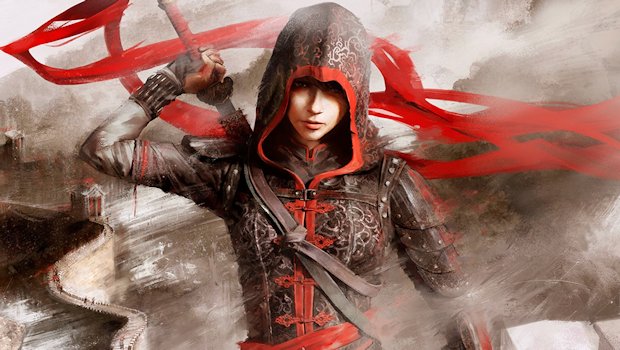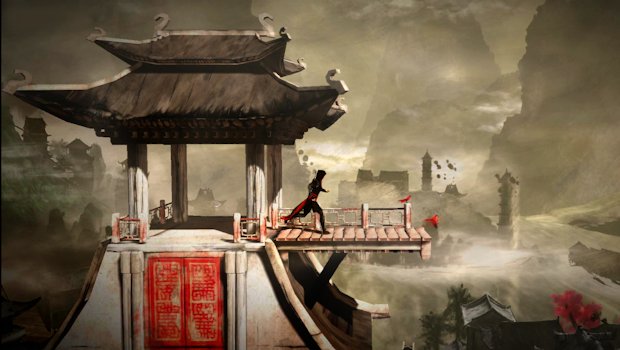Since its release in 2007, Assassin’s Creed has spawned seven primary sequels (with an eighth coming) and 13 side games that have covered nearly every platform imaginable. And the series hasn’t been content to just play within its original medium either, as it has assaulted popular culture with books, comics, and movies. It has gotten to the point where turning around may result in you getting slapped in the face by the next Assassin’s Creed thing to come out. And this is exactly what happened to me with Assassin’s Creed Chronicles: China.
I knew about Assassin’s Creed Chronicles: China only passingly. I knew it was included as part of the original season pass for Assassin’s Creed Unity and was set for release sometime this year. I knew that it was a 2.5D sidescroller. And I knew it starred a bad-ass female assassin. I didn’t know that it was coming out when it did though, and was quite shocked when I woke up and saw it sitting in the store for purchase.
Being a sucker for strong female protagonists and side scrolling platformers, I instantly made the purchase. And you know what? It’s pretty awesome.
Taking place in 1526 China, players take on the role of Shao Jun, a young assassin trained by Ezio Auditore de Firenze. Ezio entrusts her with a mysterious box that the Templars are keen to get their hands on. Using that knowledge she tricks the Templars into capturing her, putting her within striking distance of her first target. As the game progresses Shao Jun exacts vengeance, for what I’m not exactly sure, on a series of Templars and eventually saves all of China from the Mongolians. All of this is told during brief static cutscenes before and after a level. To be honest, the story is nonsensical and I’m not sure what actually happened or why. Nor do I care, because the gameplay is what fully drives AC Chronicles: China.
At the outset AC Chronicles: China is a pretty standard platformer. Shao Jun will have to run, jump, and climb through the environment and while it looks and feels good, it doesn’t necessarily feel like an Assassin’s Creed game. As she progresses in the opening level, she’ll quickly unlock new abilities that introduce strong combat and stealth mechanics to flesh out the 2.5D assassin gameplay.
Assassin’s Creed has never shied away from allowing its players to approach its gameplay however they wanted and still feel like an ultimate bad-ass. Not so great at being sneaky? No problem: just kill everyone trying to stop you from reaching your goal. Not so great at fighting? No problem, utilize the environment to become the ultimate shadow. Personally, I tend to play Assassin’s Creed a bit more action oriented, with just a touch of stealth. AC Chronicles: China is no different in this regard and in many ways it does a better job of rewarding you for being good at your particular playstyle.
Each section of a level is graded based on three different play styles. Playing stealthy and non-lethal is the way of the Shadow. Playing stealthy and lethal is the way of the assassin. And playing as an ultimate bad-ass that doesn’t care if she is seen is the way of the Brawler. The better you play in these areas, the higher your score at the end of a section. And since your score is tied to secondary character enhancements, there is always encouragement to play at your best. However, you don’t have to stick to one particular playstyle to maximize your score, and sometimes a good solid mix of all of them will be required to complete a level competently.
Stealth in AC Chronicles: China is handled by engaging in the depth that a 2.5D game allows. Shao Jun is able to hide in doorways, alcoves, behind pillars, outside windows, behind boxes, in haystacks, and a variety of other places to keep herself from notice. Just like in its 3D cousins, when an enemy walks by a hidden Shao Jun, she can assassinate them with just a quick button press. Few things in gaming are as satisfying as working your way through a series of patrolling enemies and assassinating them all in different ways. Get seen doing this, though, and combat will commence.
Combat in AC Chronicles: China is surprisingly more complicated than in the main series. Combat in this game is something you actually have to think about and plan instead of just reacting to. In the main Assassin’s Creed games combat almost always boils down to countering enemy attacks with a singular button press. AC Chronicles: China has a similar system but requires a bit more than just fast reflexes. When an enemy attacks, Shao Jun can block the attack by pressing into the attack and the block button. When being attacked by multiple enemies it becomes a test of watching for the attack tells and pressing into the proper one. At first I found it to be unintuitive because my instinct is to back away from combat. But once I conformed to the system, I found it to be super satisfying, allowing for chains of blocks, counters, rolls, and attacks to flow out of Shao Jun. Now, I never became a master at the combat (my video streams hold enough proof of that), but I got good enough that I felt accomplished when I finished off an enemy I was locked up with.
The major difference between combat in other Assassin’s Creed games and AC Chronicles: China is that a group of enemies is extremely dangerous. Shao Jun is a capable fighter but she is also not equipped to battle an army like Ezio or Kenway have in their games. Because of this, escape may sometimes be her best option from an encounter. Many times I forced Shao Jun to retreat and regroup and I did this because the alert system is somewhat broken.
Guards in AC Chronicles: China react a lot like guards in a Metal Gear Solid game. If you get spotted, they’ll pursue and attempt to kill you. But, if you can escape out of their line of site, they’ll go into a cool down mode and eventually return to their set guard paths. Unlike Metal Gear though, with the environment being 2.5D and guards not being able to follow Shao Jun down certain paths, I found myself cheesing through certain tough parts by taking out a guard, running away and having the remaining enemies reset. This didn’t detract from my overall experience but it may for others that want a more realistic approach.
That said, realism isn’t exactly AC Chronicles: China’s strong point. The game is depicted in an almost painting come-to-life style that reminded me a lot of the early promotional material for Street Fighter IV. When Shao Jun lands an attack, a blood splatter emerges from her enemies in a paint brush like stroke and it looks amazing. The color palette isn’t particularly deep, with most of it hinging on browns, blacks, and reds but it all looks quite striking, especially in motion. In fact, the game looks and plays the best when it dispenses with the stealth puzzle and combat level design and just asks Shao Jun to run. Three of the 12 memory sequences see her running through the environment as quick as possible, attempting to outrun fires or catch up to targets. In this instances the game is a pure joy, and hitting jumps, slides, taking out enemies with one hit, all feels perfect.
It’s funny because the parts I like the least in the core Assassin’s Creed games are the free-running sequences that almost always see characters slipping on geometry and taking you out of the moment, but in AC Chronicles: China, these are the best parts. But the best thing is that these sequences are just icing on an already tasty cake. AC Chronicles: China is just plain fantastic and the best showcase that Assassin’s Creed still has so much to offer its players even after so many releases. The fact that there are two more of these games coming later this year makes me incredibly happy and I can’t wait for them to get here.



